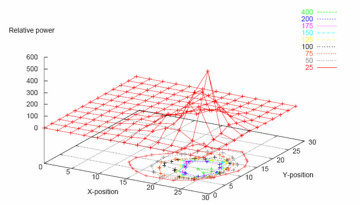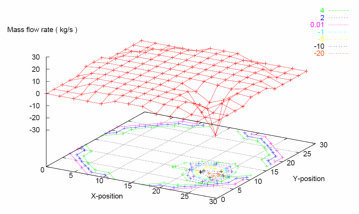Boiling water reactor (BWR) safety analyses capabilities can form the basis for customer success in multiple areas. Examples include:
POLCA-T is Westinghouse’s state-of-the-art code for BWR safety analysis with a full three-dimensional (3D) neutronic/kinetic model. The detailed modeling of the core and the plant systems provide analysis results with high accuracy. The applications of POLCA-T include stability, reactivity insertion accidents (RIA), anticipated operational occurrences (AOO) and anticipated transients without scram (ATWS) with fine motion control rod drive run-in or standby liquid control system injection.


Full-core analysis using POLCA-T for control rod drop accident from initially zero power
POLCA-T is a system computer code for transient thermal-hydraulic and neutron-kinetic analysis of BWRs. It can be used as a general tool for advanced simulation of single- and two-phase flow systems including non-condensable gases, where solution and dissolution of gases is taken into account. The code has a full 3D neutronic-kinetic model, where each fuel assembly in the reactor core may be represented in the thermal-hydraulic model in situ, as well as control rods that include intra- and inter-assembly bypass regions. The thermal-hydraulic model includes thermal non-equilibrium between phases and has full geometric flexibility, whereas the thermal-mechanical model solves the heat conduction for the heat structures (fuel rods, pressure vessel and reactor pressure vessel internal parts, etc.).
The PHOENIX/POLCA code suite is the static core simulator. It is where cell data are created for each fuel assembly type in the core. POLCA is also used to calculate the fission power distributions in the core. POLCA-T incorporates the kinetics terms used for transient calculations and iterates with POLCA to solve the two-group diffusion equations with a number of delayed neutron families determined by the code user.
The system models in POLCA-T contain models of the various reactor components. Steam separators, steam dryer, reactor water level measurement, recirculation pumps, emergency core cooling and safety and relief systems, among others, can be modeled in detail. POLCA-T also includes advanced models for the modeling of control and logical systems (SAFIR tool box). The tool box contains numerous components that can be used to model both digital and analog control, and logical systems such as pressure controller and reactor protection systems.

Westinghouse analysis code package with its application replaced by POLCA-T
The POLCA-T system analysis code with 3D core model can be used for detailed safety analyses of BWRs. The detailed modeling of the core and the plant systems provide analysis results with high accuracy, resulting in improved safety margins and more efficient operation of the plant. The methods utilized for detailed modeling are flexible and user-friendly. They allow a single plant model to be used for several applications where the main applications of POLCA-T are:
Hence, POLCA-T can replace several codes, leading to improved quality and reduced cost for plant model development and maintenance. POLCA-T also offers the following distinct advantages:
In addition, the incorporation of the core directly in POLCA-T from the static core simulator provides consistent cross-sections and geometrical representation of the core between the static and dynamic calculations.

Incorporation of core from the static core simulator POLCA, and re-use of advanced scram model and plant systems from BISON
POLCA-T has been successfully used for safety analysis for practically all existing types of BWR plants in the world, including BWR/2-6, Nordic Type Reactors and, most recently, the advanced boiling water reactor (ABWR).
POLCA-T was approved by the U.S. Nuclear Regulatory Commission in 2010 for a subset of applications, including control rod drop accident and stability. Additional application appendices for AOO and ATWS were submitted to the NRC for review in October, 2010. In Europe, POLCA-T has been successfully deployed for stability, control rod drop accident and ATWS.
User training is also available for the POLCA-T code package. It can be arranged as a general POLCA-T training or a training for specific applications of POLCA-T with its accompanying methodology.